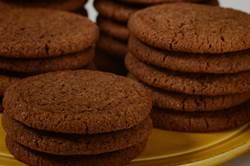The original chocolate stout cake donut served on Father's Day, 2011
Although the chocolate bock lent a nice flavor, I much prefer the smooth, almost coffee like taste of Guinness, but really you can use what ever dark stout beer you like. This is a simple cake to prepare which can be decorated however you please, but is best enrobed in melted semi-sweet or dark chocolate just to make sure people know what flavor is boss. Serve this up with a shot of espresso and maybe a dollop of freshly whipped cream and you've got a dessert that'll make the biggest chocolate fan sing!
A fantastic start to a gorgeous cake!
Chocolate Stout Cake
Adapted from Tracey's Culinary Adventure, who adapted it from Bon Apetit
Aaaaah... the good stuff!
adapted from the Barrington Brewery in Great Barrington, MA via Bon Appetit (via Smitten Kitchen)
1/2 cup stout (I used Guinness)
1/2 cup (1 stick) unsalted butter
1/4 cup plus 2 tablespoons Dutch-process cocoa powder
1 tbsp granulated coffee*
Stout, coffee and a stick o' butter = YUMMERINO!
Whisking everything together
1 cup sugar
3/4 teaspoons baking soda
3/8 teaspoon salt
1 large egg
1/3 cup sour cream**
3 ounces semisweet chocolate1 tsp vegetable oil
To make the cake: Preheat oven to 350 F. Spray a round spring-form pan well with cooking spray and dust with flour.***
In a large saucepan set over medium heat, combine the stout and the butter. Stirring occasionally, bring the mixture to a simmer. Remove the pan from the heat and whisk in the cocoa powder and coffee granules until the mixture is smooth. Set aside to cool slightly.
Meanwhile, in a large bowl whisk the flour, sugar, baking soda and salt together. In the bowl of a stand mixer fitted with the paddle attachment, beat the egg and sour cream until well blended. Add the slightly cooled stout mixture to the bowl and beat to combine. Add the flour mixture all at once and beat briefly on low speed to begin to incorporate. Remove the mixer bowl and use a rubber spatula to fold the batter to finish incorporating the dry ingredients.
Transfer the batter to the prepared spring-form pan. Bake for 30-32 minutes, rotating pan 180 degrees at the 15 minute mark for even baking. Center of cake should spring back when gently pressed. Transfer the pan to a wire rack and allow to cool for 10 minutes then turn the cake out of the pan and set it on the wire rack to cool completely.
Microwave semi-sweet chocolate in a glass measuring cup for about 30 seconds increments (each microwave is different so set the time and stay close by) until most of the way melted through. With a smooth, mix in oil until well incorporated into chocolate and forms a smooth glaze. Immediately pour over cooled chocolate sponge, allowing excess to pour over from edge to edge. For a garnish, zest an orange over the ganache and sprinkle some coffee granules over the center. Serves 8.
Velveteen chocolate stout batter
This bad boy is ready to load into the magical hot box!
** I used mayonnaise instead because that's what I had on hand. Could not taste the difference.
*** The best way to do this is to dump about a cup of flour into the greased pan, shake, roll and wiggle the pan until all surfaces are covered, then invert the pan over the flour container and tap out the excess powder.












